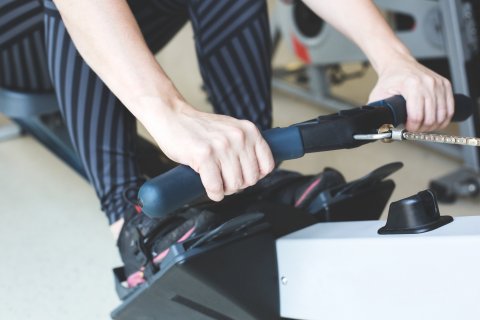You are here
Home ›Indoor Rowing

Indoor rowing machines, known also as ergometers, simulate the rowing action of waterborne rowing for the purpose of exercise or as an adjunctive method of training for rowing on water. Today rowing is a popular form of cardio in gyms around the world and provides a unique form of cross-training alternative.
Rowing can be mixed and matched with any assortment of cardio options including treadmills, elliptical machines, Stair Masters, Life Cycles, skipping, outdoor running, cycling or swimming. For best results it is theoretically ideal to move through various cardio options to prevent adaptation, staleness or boredom.
Ergometer is a technical term meaning an apparatus that measures work or energy expended during a period of physical exercise. In sports nutrition a popular related term is Ergogenic. This term describes any supplement that can enhance physical performance, stamina or recovery.
There are many safe and proven ergogenic supplements available in Canadian health food stores such as creatine monohydrate, L-Carnitine, HMB, D-ribose, carnosine, BCAAs, L-glutamine, whey protein isolate, electrolytes, Beta-Alanine, Cordyceps (mushroom extract), various forms of ginseng and Rhodiola.
Indoor rowing goes back as far as the 4th Century BCE, when an Athenian admiral ordered his men to build wooden rowing frames on shore in order to teach his soldiers rowing technique and timing for rowing on board ship.

Soldiers are physically trained for combat and survival, and everywhere today across the planet in every country with a military presence, soldiers are conditioned and trained through controlled physical exercise to enhance their capacity to survive and stay alive in tough, stressful conditions that demand a high level of functional performance.
Keep this point in mind because as a civilian the properties and benefits of controlled exercise will do exactly the same for you. Exercise is a proven method of elevating human capacity to survive and stay alive in the modern world. The goal is to improve strength, power, endurance, stamina and flexibility as well as increase tolerance to stress, infection and disease.
Rowing Technique
With rowing the resistance is created by how hard you push with your legs or pull with your arms, so you control the intensity of each session. The rowing stroke is divided into four basic phases known as the ‘catch’, the ‘drive’, the ‘finish’ and the ‘recovery’.
It’s best to have a personal trainer or rowing expert teach you good rowing technique and also watch how you row. I’ve seen many more members row incorrectly than correctly and it’s always because the person hasn’t received decent instruction.
Another great way to learn proper technique is to watch how rowing is performed correctly on the internet. A great site that will give you more than bargained for is www.concept2.com. Concept 2 is one of the most popular indoor rowing equipment brands in the world.
Rowing Workouts
Of course the old standby with cardio is to just get on the device and start using it for 20, 30 or 60 continuous minutes at a low to moderate pace.
It’s up to each one of us to ‘float our own boat’, but for best results and improved overall fitness, that strategy has been replaced with a newer, more effective style of exercise called interval training. Interval training is more intense and typically shorter in duration.
Interval training is ideal for those with time restraint issues, as ten minutes of high-intensity interval training (HIIT) is superior in many ways to someone jogging on the treadmill for one hour. First you burn more fat not only during this anaerobic style of cardio workout, but also over the next 24 hours as your body compensates metabolically from the intense exertion.
You can also elevate your heart rate to a level not possible at a moderate continuous pace. The good news is this effect is not only wonderful for heart health but also for preserving and building new muscle.
The idea is to warm-up for say 5 minutes at a moderate pace then row harder and faster for 2 minutes, followed by a subsequent return to your original moderate pace. After 1-2 minutes at this recovery pace, depending on your fitness level, you then crank it up again for 2 minutes.
Each training interval is called a ‘piece’ and an entire workout on average will include 3-12 pieces. Individual pieces can vary from short (2 min) to medium (6 min) to long (15 min). The workout variation is vast and perfect for those who enjoy variety.
Benefits of Rowing
Using a rowing machine can help build and tone your muscular system, strengthen your cardiovascular function and increase your stamina. Rowing machines are particularly effective for older folks because they place no strain on the back and joints.
A vigorous workout on a rowing machine utilizes plenty of calories as rowing uses virtually every major muscle group in the body with each stroke including the legs, hips, buttocks, back, shoulders and arms.
The trunk and core are also nicely stimulated throughout the entire stroke. If you've never tried indoor rowing why not give it a shot. The most you will lose is the a priori non-experience.
Photo by Shopify Partners from Burst

As always...Stay Well and Live Free!
Dr.C
---
- Log in to post comments